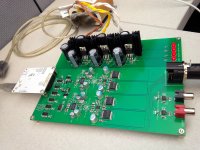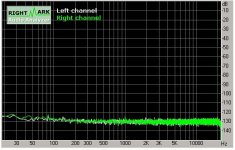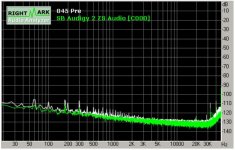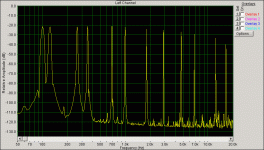...Nice finish...
You must be referring to the elegant use I made of newsprint to cover a glue line!
They deserve a nice finish and will get it when the weather warms up. Trying to decide on which veneer. Have some timborana, that would look nice.
AAA Figured Timborana Veneer Lot 15.5" x 62.75" 6 Sheets Per Lot - VeneerSupplies.com
I wasn't there long enough and only Dave got a chance to listen to my DAC.
The white board is an isolated USB-I2S converter from DIYINHK. The pin header is compatible with the XMOS one they sell as well.
The digital section converts from I2S to right-justified and delays the right channel data so it aligns with the left (otherwise it would just be a dual left channel DAC). This section runs on 5V instead of 3.3V because the DAC ICs accept 5V inputs and the digital chips switch faster on higher voltages. The last chip in the group is a D type flip-flop to reclock the data.
I upsample 44.1khz and 48khz music to 176khz and 192khz respectively using SOX2 in Foobar with no anti-aliasing filter. The DACs have oversampling and thus the digital filter disabled.
The current reference is a JFET CCS instead of a simple resistor. The I/V is passive, followed by a differential analogue low pass with an F-3 of around 35khz. Embedded in the feedback loop of the filters are buffers, so it will drive headphones directly via the XLR. From DAC IC to headphones it's DC coupled differential.
I hope to take some measurements on it later today or tomorrow.
The white board is an isolated USB-I2S converter from DIYINHK. The pin header is compatible with the XMOS one they sell as well.
The digital section converts from I2S to right-justified and delays the right channel data so it aligns with the left (otherwise it would just be a dual left channel DAC). This section runs on 5V instead of 3.3V because the DAC ICs accept 5V inputs and the digital chips switch faster on higher voltages. The last chip in the group is a D type flip-flop to reclock the data.
I upsample 44.1khz and 48khz music to 176khz and 192khz respectively using SOX2 in Foobar with no anti-aliasing filter. The DACs have oversampling and thus the digital filter disabled.
The current reference is a JFET CCS instead of a simple resistor. The I/V is passive, followed by a differential analogue low pass with an F-3 of around 35khz. Embedded in the feedback loop of the filters are buffers, so it will drive headphones directly via the XLR. From DAC IC to headphones it's DC coupled differential.
I hope to take some measurements on it later today or tomorrow.
Attachments
Thanks for the offer, Mark.
I didn't have time to hear Tyler's DAC and a number of other things, and some other people were disappointed about what they missed. As I was leaving Sunday there was talk of getting together again, maybe in April, "just to listen". Who's interested?
I didn't have time to hear Tyler's DAC and a number of other things, and some other people were disappointed about what they missed. As I was leaving Sunday there was talk of getting together again, maybe in April, "just to listen". Who's interested?
Been traveling, so late on the response. It was great to see everyone and meet a few new faces. I was able to catch John and Mark's presentations, very enjoyable, and Pierre, thanks for helping organize the hall.
Yes, I did get to hear Tyler's DAC. Tyler, thanks for describing its design, I really enjoyed your short presentation. Listening to it on excellent headphones I was unfamiliar with, it was very neutral and clean, the kind of sound I like. Please bring it to the next get together, this deserves a much broader audience! It would be really interesting to hear it over speakers into a balanced pre-amp as well.
So much gear so little time!
Dave
PS depending on time frame, a just listen session would be fun
Yes, I did get to hear Tyler's DAC. Tyler, thanks for describing its design, I really enjoyed your short presentation. Listening to it on excellent headphones I was unfamiliar with, it was very neutral and clean, the kind of sound I like. Please bring it to the next get together, this deserves a much broader audience! It would be really interesting to hear it over speakers into a balanced pre-amp as well.
So much gear so little time!
Dave
PS depending on time frame, a just listen session would be fun
Hi Tyler,
Depending on your sound card, you might be bale to get down to -110 or so, using some freeware analyzers out there meant for the PC. I atttached a noise loopback of my ESI Julia for example (great sounding card too), using RightMark Audio Analyzer.
I designed an active op-amp based pre-amp a number of years ago, and attached is the measurement I was able to get off it with a 12Phi tone IM signal I created, using a different PC-based analyzer (better than using RightMark Audio Analyzer) and an old Audigy card.
Dave
Depending on your sound card, you might be bale to get down to -110 or so, using some freeware analyzers out there meant for the PC. I atttached a noise loopback of my ESI Julia for example (great sounding card too), using RightMark Audio Analyzer.
I designed an active op-amp based pre-amp a number of years ago, and attached is the measurement I was able to get off it with a 12Phi tone IM signal I created, using a different PC-based analyzer (better than using RightMark Audio Analyzer) and an old Audigy card.
Dave
Attachments
Hi Mark,
It's SpectraLab. I've had it for about 10 years and run it on an old Win2k machine that has a very accurate sound card. I don't know what the latest version is or if its supported on modern Windows systems.
RMAA has some issues:
NwAvGuy: RightMark Audio Analyzer
"Some of the FFT/math used to calculate the results is apparently wrong and/or has serious limitations that are neither properly documented nor obvious. In my experience the results often disagree with a professional audi analyzer."
I used to have a link that itemized these errors, but couldn't find it.
It's SpectraLab. I've had it for about 10 years and run it on an old Win2k machine that has a very accurate sound card. I don't know what the latest version is or if its supported on modern Windows systems.
RMAA has some issues:
NwAvGuy: RightMark Audio Analyzer
"Some of the FFT/math used to calculate the results is apparently wrong and/or has serious limitations that are neither properly documented nor obvious. In my experience the results often disagree with a professional audi analyzer."
I used to have a link that itemized these errors, but couldn't find it.
There have been updates to the RMAA program:
Latest News. Audio Rightmark
Thanks for the link to the thread discussing the strong and weak points of the program. There is an interesting back and forth in the comments section between the author of the thread and author of RMAA.
I have SpectraLab:
Information DL4YHF's Audio Spectrum Analyser
Download DL4YHF's Audio Spectrum Analyser
Good information to have Dave. Thanks!
Latest News. Audio Rightmark
Thanks for the link to the thread discussing the strong and weak points of the program. There is an interesting back and forth in the comments section between the author of the thread and author of RMAA.
I have SpectraLab:
Information DL4YHF's Audio Spectrum Analyser
Download DL4YHF's Audio Spectrum Analyser
Good information to have Dave. Thanks!
- Status
- This old topic is closed. If you want to reopen this topic, contact a moderator using the "Report Post" button.
- Home
- Member Areas
- Clubs & Events
- DIY Audio Ottawa 21-22 Feb 2015



